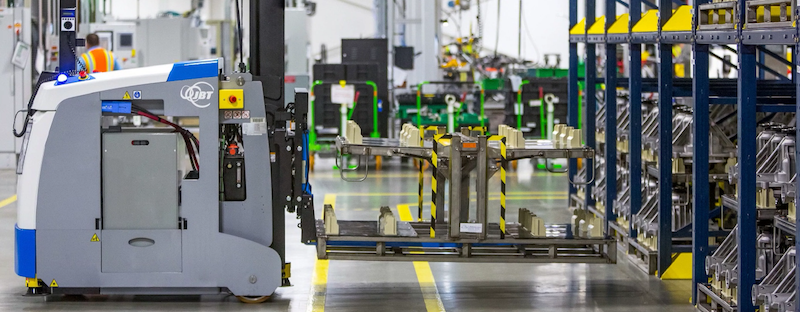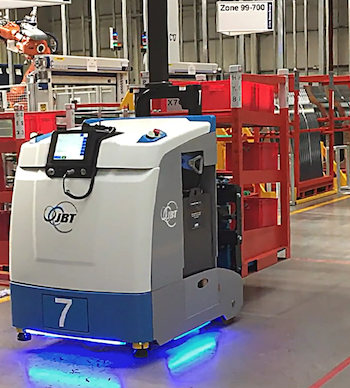
JBT is working with automotive manufacturers to offer a range of a provider of automated guided vehicle solutions, in line with the transformation to Industry 4.0
 Automotive manufacturers have become experts on automation. However, from the vantage point of automation suppliers, the needs of their automotive clients are unique.
Automotive manufacturers have become experts on automation. However, from the vantage point of automation suppliers, the needs of their automotive clients are unique.
This is especially true for automated guided vehicle (AGV) providers. In particular, material movements in the automotive industry – which include racks and other speciality loads, in addition to pallets – mean that AGV manufacturers have to deliver more flexible solutions. In most applications, automotive facilities require several different types of vehicles, each of which performs a different function. Case studies from JBT, an AGV provider, help illustrate exactly how the automotive industry is different and how automotive OEMs can best leverage an expansive AGV programme.
In one of JBT’s stamping installations, AGVs operate in several areas of the bodyshop. This 17-vehicle system features tugger AGVs, which stay hitched to trains carrying full and empty racks. When these vehicles pull up to unloading stations with loads, manual forklift operators pull product from the trains. The same holds true for the loading stations, where operators place full racks on to trains. Across the bodyshop, tuggers stop at 15 different load and unload stations. They also charge at these stations by engaging with charging plates placed on the floor. This allows them to function within the plant for its entire 24/6 operation.
At the same facility, which also contains a powertrain plant, 11 forked AGVs – eight counterbalance-style and three reach-style – support pallet movement between machining areas, storage flow rack and assembly lines. These pallet movements occur across all facets of the powertrain manufacturing process. This AGV system, which supports 70 pallet movements per hour, hooks into the facility’s enterprise resource planning (ERP) system in order to provide transparency throughout the system.
Installed in several different phases, the project was part of a strategic initiative by the customer to automate its entire enterprise. In order to prove out the benefits of an AGV system – in particular its operational efficiency – the customer started small and gradually added AGVs. This strategic initiative is an ongoing process, both in the aforementioned facility and for the customer as a whole. Since starting the installation at this combined stamping and powertrain plant, the manufacturer has added several other AGV systems to its network.
Double installation
In another example of an automotive manufacturer installing JBT AGVs at multiple facilities, an automotive OEM in Europe has installed vehicles in two different locations. At the first site, the company provided a customised AGV solution that met the customer’s need for JIT transports of custom-made racks, containing kitted assemblies. With a system comprising unit load vehicles, JBT helps the automotive manufacturer support lineside operations. Its vehicles interface with flow racking to deliver the JIT transports. Plus, its software tracks inventory throughout the facility.
At the OEM’s second location, forkover AGVs transport boxes and stillages within the facility at a rate of nearly a load movement every minute, across a 24/5 operation. These loads contain a variety of parts that are used to build kits and support lineside operations. This particular installation presented a unique challenge – moving loads on and off elevators to support operations on a mezzanine floor. But AGVs use PLC-driven communications between the vehicles and the elevators to accomplish this task and to ensure smooth transfer of loads.
 Aside from this operation, the AGVs also support an automated high-density storage system. At the lineside itself, 2018operators use pushbuttons to call for AGV transports of parts. These pushbuttons communicate with the facility’s warehouse management software (WMS), which interfaces with the AGV control system. By interfacing with the WMS, the AGVs and the operators monitoring the system, always know what product is where and when it is being moved.
Aside from this operation, the AGVs also support an automated high-density storage system. At the lineside itself, 2018operators use pushbuttons to call for AGV transports of parts. These pushbuttons communicate with the facility’s warehouse management software (WMS), which interfaces with the AGV control system. By interfacing with the WMS, the AGVs and the operators monitoring the system, always know what product is where and when it is being moved.
Dual-floor management
A third automotive manufacturer has also utilised JBT’s counterbalance AGVs to support production on two different floors. At this installation, which is also a part of a long-term, enterprise partnership, AGVs transport metal stillages. Containing over 17 different part SKUs, these stillages support the body and assembly processes occurring within the facility. The AGVs themselves move stillages across both the upper and lower levels and maintain 45 material movements per hour in throughput. As in the previous examples, JBT’s AGV control software, SGV Manager, interfaces with the ERP system to provide efficiency.
In fact, this software interface between SGV Manager and ERP or WMS systems offers significant advantages, especially when viewed in the context of the automotive industry’s focus on Industry 4.0 initiatives. This AGV control software helps end users to gain operational insight, while also controlling vehicle movements. The performance analytics offered by SGV Manager include a variety of data points, such as overall efficiency, system monitoring and maintenance. Because the automotive industry requires a streamlined manufacturing process to support its high production volume, these types of insights prove critical. Transparency and detailed reporting help OEMs optimise production. In fact, these requirements have helped push the automotive industry into the forefront of the Industry 4.0 manufacturing transformation. These suppliers know that 4.0they need to stay ahead of the game.
Clearly, the automotive industry requires a variety of different AGV solutions. Due to the industry’s various processes, namely operations in stamping, powertrain, and assembly facilities, material movements necessitate dedicated, specialised attention from automation providers. Plus, with Industry 4.0 transformation driving new automation projects, AGV suppliers – now more than ever – have to recognise the pain points associated with these plants. As an AGV provider with nearly 30 years of automotive experience, JBT has demonstrated that it not only devotes this specialised attention to its automotive clients, but also that it has a unique understanding of their needs. Ultimately, a transparent discussion of an automotive OEM’s requirements will prove the most fruitful in developing an effective solution.
AGVs take centre stage in Chicago
JBT’s line of AGV systems took centre stage at this year’s Pack Expo, held at Chicago’s McCormick Place Convention Center. JBT showcased the CB750, a counterbalance-style forklift AGV capable of carrying 750kg, which ran host-free at the show. What this means in practice is that the forklift operates without any high-level software and makes all the intelligent decisions itself. Ideal for handling pallets, racks, and rolls, the counterbalance AGV excels in floor-to-floor transfers and its end-mounted lift mast allows the vehicle to move multiple load types without complications.However, one of the most outstanding attributes offered by the AGV is its ability to deliver substantial efficiency savings. Manufactured in the US – as well as the UK for Europe and China for Asia, respectively – the AGV units remove repetitive and wasteful work practices, enabling companies to redeploy resources more effectively. “Most of what we’re delivering to customers is labour savings,” says Mark Longacre, JBT’s applications manager for automated systems. “We think of that as allowing them to redeploy labour to where they can create more value in their process. Having people on a forklift, moving products from one end of the plant to the other all day, does not add value to the product. In reality, it can affect safety and often does. People get bored and careless and make mistakes, which can create accidents and personal injury, as well as plant and product damage.”





































